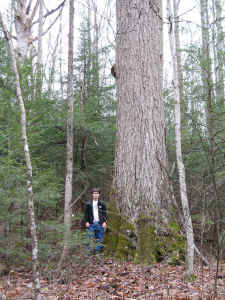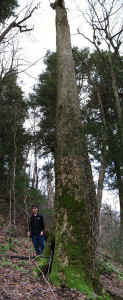Ents,
A few weeks ago Michael Davie and I set out to the Smokies to
make use
of a new tool for measuring tree volumes. We used a monocular
with
eight-power magnification and an internal scale (reticle). The
reticle is the crucial element that allows diameters to be
remotely
measured. Using perspective or similar triangles, the number of
units
on the internal scale masked by the trunk can be converted to a
trunk
diameter. Repeating the process on different parts of the trunk
and
from different vantage points allows the volume of the trunk to
be
calculated. Will Blozan and I have repeatedly tested the unit
under
different conditions, and found that the calculated diameters
fall
within half an inch of actual diameter. In another test, we were
able
to calculate the volume of a hemlock trunk to within one to two
percent of volume obtained by climbing.
The first objective of our trip to the Tennessee side of the
park was
to model the trunk of a huge tuliptree that my dad and I found
several
years ago. The tree, with strikingly heavy branching, grows at
only
approximately 2760' elevation, and at the upper edge of gentle
slope
many acres in extent. The tree is also within a mile of Cosby
Campground, an area of extensive farming, a further indication
of the
easy accessibility of the tree. For whatever reason, the tree
and
surrounding forest were not cut, and the tree has now reached
20'5.5"cbh and 146.6' tall.

The tuliptree on Inadu Creek that was modeled - photos by
Michael Davie
We mounted the monocular on a tripod and shot the tree from two
positions separated by roughly 90 degrees. Screening vegetation
somewhat limited the points on the tree that the rangefinder
could
see, so we did not attempt to measure the same cross-sections
from
both sides to calculate elliptical areas. By direct tape
measurement,
the tree measures 24'8.5" at ground level, and, with a
typical concave
lower trunk profile, reaches 17'4" at 14.6'. From there to
63.4',
where the first branch begins to emerge from the trunk, the tree
maintains a columnar form with a diameter of slightly over five
feet
(15'8.5" c) diameter. Those measurements yield a calculated
trunk
volume of 1770 ft^3. That figure does not include the portions
of the
trunk below the upslope base or the above the highest measured
diameter. Including those sections would yield a volume between
1800
and 1900 ft^3. Beyond that massive trunk, the tree has five
branches
over two feet in diameter, which at greatest extent span 114'.
Assuming the tree has the same ratio of limb to trunk volume as
the
Sag Branch tuliptree, which seems reasonable given the size of
the
branches, the tree's total volume comes to approximately 3000
ft^3.

The northern red oak that was modeled using a monocular on Inadu
Creek
With the little time we had remaining, we went down the to look
at a
large, declining northern red oak. One fork of the tree had
rotted
away leaving a gaping hole in the trunk and a conspicuously
tapered
form. Some flaring around the base gave the tree a 17'8"
cbh using a
minimal amount of wood. The other taped circumferences were
24'5" at
upslope ground, 20'2.5" at 2.5', and 16'2" at 6.5'.
Using the reticle
from one vantage point yielded diameters corresponding to
circumferences of 14.2' at 16.9' height, 13.6' at 33.6', 10.3'
at
57.8', and 8.3' at 79'. Together, these measurements indicate a
volume of 1040 ft^3 without any limbs.

A large cucumber tree along Inadu Creek
The tuliptree may well be one of the 10 largest in the Smokies.
The
thousand cubic foot difference between this tree and the Sag
Branch
Tuliptree illustrates just how big the Sag Branch tree is. The
range
in volumes may seem surprisingly large, but the range is
proportionally similar to what BVP reports for many species in
Forest
Giants of the Pacific Coast. However, the northern red oak does
not
approach the largest of the species. An oak on Boulevard Prong,
also
in the Smokies, looks to be in the 2000 to 2200 ft^3 based on
eyeball
estimates. The Double Gap northern red oak likely achieves
similar
volume.
Jess Riddle & Michael Davie
|